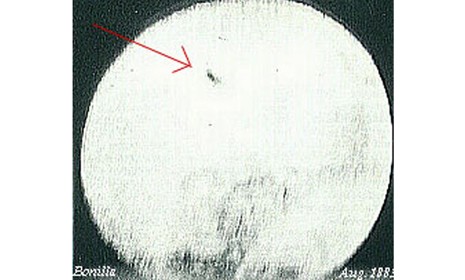Did a massive comet almost wipe out humans in 1883?
New research suggests that a giant celestial missile, much like the one that killed off dinosaurs, nearly did the same to humans a century ago

For two days in August 1883, Mexican astronomer Jose Bonilla was the lone witness to 450 heavenly objects passing across the face of the sun, each one surrounded by a glowing mist. When Bonilla later published his findings in the French journal L'Astronomie, his editor dismissed the phenomenon as flecks of dust or bugs obscuring Bonilla's telescope. But now, a new study by researchers at the National Autonomous University of Mexico offers a different, sobering take: The objects Bonilla saw were actually fragments of a massive comet that narrowly missed Earth. Here's what you should know:
How big were these heavenly bodies?
Big. At the small end, they were 164 feet across. The biggest were 2.5 miles wide. Each one was exponentially more powerful than an atomic bomb. What's more, "the parent comet must originally have tipped the scale at a billion tons or more," says Technology Review. That's quite similar in mass to the celestial object suspected of killing off the dinosaurs when it struck the Earth 65 million years ago.
The Week
Escape your echo chamber. Get the facts behind the news, plus analysis from multiple perspectives.

Sign up for The Week's Free Newsletters
From our morning news briefing to a weekly Good News Newsletter, get the best of The Week delivered directly to your inbox.
From our morning news briefing to a weekly Good News Newsletter, get the best of The Week delivered directly to your inbox.
Why do scientists suspect it was a giant comet that Bonilla saw?
Comets are "the only bodies in the solar system" that have a "bright mistiness" similar to what Bonilla witnessed, say the study's authors. "Our working hypothesis is that what Bonilla observed in 1883 was a highly fragmented comet, in an approach almost flush to the Earth's surface."
Why was Bonilla the only one to see it?
Because the objects came close to Earth — anywhere from 373 to 4,970 miles — an obscuring called "parallax" occurred, says Wired's Mark Brown. Essentially, only certain regions of the Earth lined up with both the sun and the comet fragments — much in the same way that only certain locales are able to view a lunar eclipse. In this case, northern India and southeast Asia are among the only other places where people might have seen what Bonilla witnessed — and they "weren't exactly astronomy hotspots in 1883."
A free daily email with the biggest news stories of the day – and the best features from TheWeek.com
Was the comet really that dangerous?
Yes. If these fragments had hit our planet, we probably wouldn't be here. In 1908, an object of similar size smashed into Russia, in what history has dubbed the Tunguska event. The blast was "1,000 times more powerful than an atomic bomb," says Brown. If Bonilla's observations were correct, then the Earth could have seen "3,275 Tunguska events in two days," says one of the new study's authors — "probably an extinction event."
Sources: Daily Mail, Technology Review, Wired
-
 7 bars with comforting cocktails and great hospitality
7 bars with comforting cocktails and great hospitalitythe week recommends Winter is a fine time for going out and drinking up
-
 7 recipes that meet you wherever you are during winter
7 recipes that meet you wherever you are during winterthe week recommends Low-key January and decadent holiday eating are all accounted for
-
 Nine best TV shows of the year
Nine best TV shows of the yearThe Week Recommends From Adolescence to Amandaland